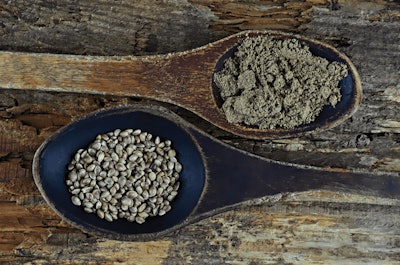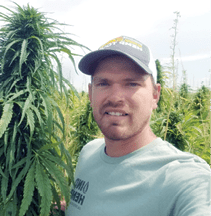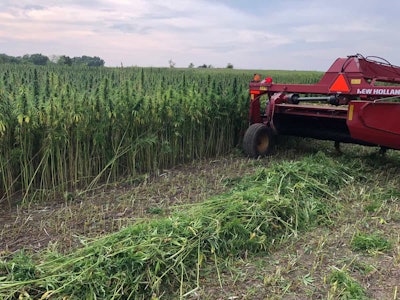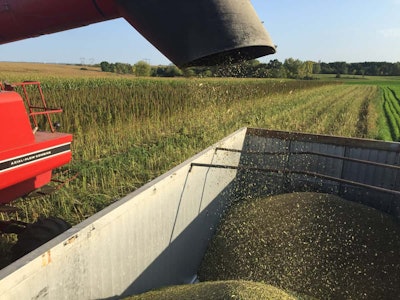


John Strohfus
When John Strohfus, founder and CEO of Minnesota Hemp Farms, first planted hemp in 2016, the two 9-acre plots were Minnesota’s first hemp crop in more than half a century. Operating under the 2014 Farm Bill, Strohfus saw an opportunity to make his 100-acre family farm more profitable and diverse. But unlike many would-be hemp farmers, Strohfus set his sights on hemp grain—the harvested seed destined for uses beyond planting.
In the years since then, the hemp industry’s very public growing pains have consisted of hemp cannabinoid farmers left with excess biomass, unkept promises and broken dreams. But for Strohfus and other grain growers focused on hemp grain for food production and consumer packaged goods (CPG), another story is taking place.
Interest and Acreage
According to the U.S. Department of Agriculture’s (USDA's) Farm Service Agency (FSA), planted hemp acreage reported in the U.S. was down across the board in 2021 by nearly 50% from the previous year. Acreage in hemp grain was no exception. But interest in the crop is building, and acreage could soon follow suit.
Seth Boone is vice president of business development and head of hemp markets for PanXchange, a commodities trading platform. He notes that the 2020 FSA final report showed roughly 11,000 reported acres of hemp planted for grain use. In contrast, the latest FSA figures, dated Nov. 9, 2021, only show about 5,800 reported acres planted for hemp grain in 2021.
Boone feels those numbers don’t tell the whole story, with grain crops potentially going unreported, underreported and misreported. He believes trial grain crops may be misreported as crops of planting seed. Similarly, tri-crop or dual-crop acreage that includes hemp grain may be reported under cannabinoid or fiber acreage.
The USDA’s National Agricultural Statistics Service (NASS) first-ever Hemp Acreage and Production Survey could help clarify the real stats for U.S. hemp grain. Sent to 20,500 known U.S. hemp producers in October, the NASS survey will provide the industry’s first in-depth look at U.S. hemp production when results are released in February 2022.

Boone believes U.S. hemp grain production is a food-driven market that needs more grain to meet rising demand. He predicts hemp grain’s path will be similar to flax. “What we’ve seen there is production rapidly increased following demand, and I think hemp’s going to follow that same [trajectory],” he says.
Eric Singular, senior hemp analyst for analytics firm New Frontier Data (NFD), says traditional farmers are interested in adding hemp grain to their crop rotations, despite the stories they’ve heard about industry struggles. Still, some growers are being cautious because of the stigma and variability that still exists in the industry, say sources Hemp Grower spoke with. “I think they’ve seen a lot of wonder crops come and go, and they’re just interested in a new rotational crop, which this ultimately is,” Singular says.
In addition to his work with NFD, Singular also serves as director of communications and business development for International Hemp, a producer and distributor of industrial hempseed for planting that is certified by both the Association of Official Seed Certifying Agencies (AOSCA) and the Organization for Economic Cooperation and Development (OECD).
He notes two interesting trends: Some manufacturers are seeking large quantities of harvested grain hemp prior to the 2022 harvest, saying they under-contracted grain production for 2021. He’s also seeing fewer licenses being issued, but the growers receiving licenses are scaling production.
Ben Brimlow is lead agronomist for Montana-based IND Hemp, a hemp grain and fiber producer-processor. He works with a network of approximately 40 farmers throughout Montana, Washington, Oregon, North Dakota and Idaho on genetics, field selection, planting, harvesting, storage and processing at IND’s oilseed facility.
The company has a 60-acre threshold for new farmers, but Brimlow says some veteran farmers may raise more than 1,000 acres of hemp grain. (IND production figures underscore the inconsistencies in FSA acreage reports: For 2020, Brimlow says IND had about 10,000 acres in grain production.) After scaling back slightly in 2021, he says IND plans to work with growers to produce up to 20,000 acres of hemp grain for 2022.

At Minnesota Hemp Farms, in addition to working with about 10 growers in Minnesota, North Dakota, and Canada, Strohfus grows hemp on his own farm each year along with several other crops.
He and his network make sure to have contracts in place to ensure they can move the product they grow. And while Strohfus won’t specify how many acres he and his network grow, he will talk increase for 2022. He says he’s worked hard at generating interest and demand for his CPG brand, Field Theory. “I will tell you that acres will increase because demand is increasing for the products that we sell,” he says.
Cultivation and Handling
Harvested hempseed is widely referred to as grain, but “true grains” are crops like barley and wheat, which are members of the Poaceae family. Instead, hemp is an oilseed crop that can be kept whole or crushed for its oil—like sunflowers, canola or flax—and also used for the nutrient-rich meal left behind. While it’s considered an oilseed crop, when it comes to growing, hemp shares similarities with both other oilseeds and grains.
Brimlow says traditional field crop growers have an advantage when it comes to growing hemp for grain in terms of cultivation, existing equipment and grain storage, handling, and processing. “If they grow cereals, oilseeds or pulses, they’re a near-perfect fit in most cases,” Brimlow says.
“One of the biggest challenges to raising the crop is it does break rules,” Brimlow says. For example, contrary to some traditional crops, ideal harvest time for grain hemp is when the stalk is still green. “But in other respects, hemp behaves a lot like oilseed crops in terms of nutrient and crop rotation. I would say it’s most similar to flax,” he adds.
Boone says those similarities help explain why the northern Great Plains region suits hemp grain well: The environment fits established hemp grain varieties, and the market and infrastructure for small specialty grain-like crops, such as yellow peas and lentils, already exists. (For more information on cultivation and handling, see the sidebars below.)

Courtesy of John Strohfus


Processing Infrastructure
Strohfus says U.S. hemp grain processing was practically non-existent when he grew his 2016 crop. “There was nobody doing this for hemp grain,” he shares. Smaller growers had an especially tough time when reaching out to processors that were used to large quantities of familiar oilseeds and grains.
Today, he says hemp grain growers are no longer laughed at when calling a processor, provided they have sufficient volume to make it worthwhile. He recommends starting with specialty processors already doing sunflower seeds, flaxseed and similar oilseed crops and products, and making sure the facility has all the certifications to satisfy a target buyer.
Singular says the U.S. infrastructure to process hemp grain into a usable food ingredient existed long before the passage of the 2014 and 2018 farm bills in the U.S. “America is a leading processor of grain. Look at the NOPA—National Oilseed Processors Association—you’ll find there are oilseed processors all over the country,” he says.
The hurdle goes back to acreage and production. Singular says the nation’s largest oilseed processors typically work with crops that represent millions of production acres. It’s not economically feasible for these large processors to add hemp grain to their schedules until quantities increase. He says that’s why the “smaller, more boutique” U.S. hemp grain processors coming online are critical to industry growth.

Products and Potential
As an oilseed crop with grain-like uses, the potential for hemp grain products seems to know few bounds. Many consumers are familiar with cold-pressed hempseed oil, hulled hempseeds (aka hemp hearts), roasted hull-on hempseed snacks and hemp protein powder, as well as cosmetics and skincare products enhanced with hempseed oil. But those products just scratch the surface of what may be ahead.
Singular believes the rise of plant-based protein additives is a major driver behind increased demand. In his role with International Hemp, he is working to make large food manufacturers aware of hemp grain and its nutritional analysis.
“We can sit around and wait for the food manufacturers to get more interested, which is going to drive up the demand and get more acres planted, or we can go and try to pave that way,” he says. He believes a new wave of growth is near as food researchers and food scientists become interested in hemp grain and what it can replace.
Strohfus has a similar mission. “You don’t have to raise that many acres of hemp to feed a lot of people who are putting hemp hearts on their yogurt every morning or in their salads,” he says. “So, how can we create more demand for farmers to grow more?”
The answer, he says, is to tell manufacturers and bulk ingredient buyers to use hemp grain and its derivatives as ingredients in mass-produced mainstream products like protein bars, crackers, chips, pasta and more. “Let’s diversify. Let’s not be a raw ingredient in a bag. Let’s be a full-value ingredient in, like, a pancake mix or a muffin mix or a chip,” he says.
“As plant-based proteins continue to become more in demand by brands and consumers, this space will continue to evolve,” Strohfus says. He notes that he and many others in the industry are working on innovations that, if achieved at a commercially viable price, can compete with other proteins—including pea protein, which has had great success. Hemp milk, formulated with de-hulled grain, water and other ingredients, is another area driving more demand, as products such as oat milk drive growing interest in plant-based “dairy” beverages.
The U.S. Food and Drug Administration (FDA) has given GRAS (generally recognized as safe) status to hemp grain and its derivatives—a status that still eludes hemp-derived CBD. But that approval doesn’t apply to animal feed. The Hemp Feed Coalition (HFC) has been working to change that.
Montana approved hemp and hemp-derived substances for in-state use in commercial feed for pets, specialty pets, and horses in May 2021. But the rest of the country is still waiting for that market break, which could trigger expanded production and stabilize the non-food grade grain market.
Boone says FDA and Association of American Feed Control Officials (AAFCO) approval are essential to the animal feed market, but he’s optimistic about hemp grain’s future, short and long term.
“With everything that we’ve been through with CBD as an industry as a whole, we really need to look at this from an unemotional perspective and look at the economics,” which are starting to be more favorable for farmers growing hemp for grain, he says.
Canadian Connections and Domestic Growth
Singular underscores that Canadian production has dominated the hemp grain market for decades, but as Canada continues to shape the market’s future, a shift toward U.S. grain production is underway.
Brimlow believes U.S. hemp grain production will catch up to Canada—and that Canada is helping that come to pass. “They’ve had an edge on the market, but they’ve been fairly open to supporting American growers and American industry,” he says. “… I most definitely believe grain hemp is here to stay in the U.S. and will increase over time.”
While some companies emphasize “American-grown,” Strohfus prefers “North American-grown.” He believes that the U.S. hemp grain industry would not exist if not for Canadian help to date. He urges others to not let the border box in the U.S. hemp grain industry. “Let’s not be isolationists, because we have great partners to work with in Canada and other places, frankly, around the world,” Strohfus says.
Singular is optimistic about future growth, stating: “I think what the real value proposition of the 2018 Farm Bill supposed was that we were going to re-legalize industrial hemp to foster a new source of revenue for American farmers and ultimately foster a new market around a commodity that would be grown, processed, manufactured and sold in the United States.
“I think that what we’re really interested in is seeing that domestic supply chain come to fruition. Just looking at the amount of acres that are grown for corn, wheat and soy in this country, if hemp even took up a fractional percentage of where those crops are at, that would be huge.”


















